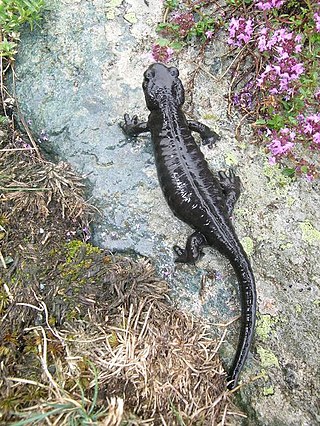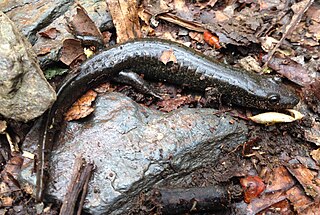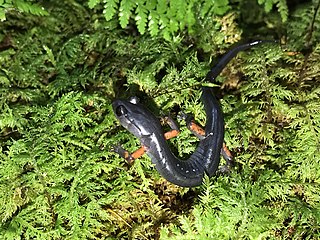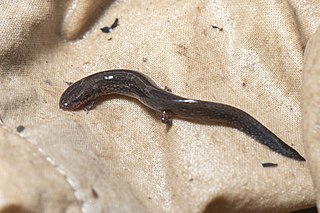
Lanza's alpine salamander or the large alpine salamander is a species of salamander in the family Salamandridae, found in France and Italy. Its natural habitats are forests, grasslands, and pasturelands, all of which are temperate. It is threatened by habitat loss and potentially in the future by the fungal disease Batrachochytrium salamandrivorans.

Desmognathus fuscus is a species of amphibian in the family Plethodontidae. The species is commonly called the dusky salamander or northern dusky salamander to distinguish it from populations in the southern United States which form several distinct species, the southern dusky salamanders. The northern dusky salamander is the most widespread representative of its genus in Canada. It can be found in eastern North America from extreme eastern Canada in New Brunswick south to South Carolina. The size of the species' total population is unknown, but is assumed to easily exceed 100,000. The species' habitat differs somewhat geographically; dusky salamanders in the northern part of the range prefer rocky woodland streams, seepages, and springs, while those in the south favor floodplains, sloughs, and muddy places along upland streams. They are most common where water is running or trickling. They hide under various objects, such as leaves or rocks, either in or near water. Alternatively, they may enter burrows for protection. The dusky salamander lays its eggs close to water under moss or rocks, in logs, or in stream-bank cavities. The larval stage which follows is normally aquatic.

The imitator salamander is a species of salamander in the family Plethodontidae. It is endemic to the Appalachian Mountains in the southeastern United States.

The shovelnose salamander is a species of salamander in the family Plethodontidae. It is endemic to the United States.

The ocoee salamander is a species of salamander in the family Plethodontidae. This salamander has a variety of colors and patterns, and got its name from Tennessee state wildflower. Its natural habitats are temperate forests, rivers, intermittent rivers, freshwater springs and wet rocks in mountainous areas of the Southeastern United States. It was first described by Nicholls in 1949. They are territorial and feed on small invertebrates. It is widely distributed in the southeastern United States and is listed as "Least Concern" by the International Union for Conservation of Nature.

The blackbelly salamander is a species of salamander in the family Plethodontidae. It is endemic to the United States. Its natural habitats are rivers, intermittent rivers, and freshwater springs. It is threatened by habitat loss.
The black mountain salamander is a species of salamander in the family Plethodontidae.

The Scott Bar salamander is a species of salamander in the family Plethodontidae, endemic to the United States, where it is restricted to a very small range in the Scott River drainage in Siskiyou County, California, at altitudes between 700 and 1,300 metres above sea level. Described in 2005, it is one of the most recently described species in the large genus Plethodon.

The white-spotted slimy salamander is a species of salamander in the family Plethodontidae endemic to the Eastern United States. It is one of 55 species in the genus Plethodon, and was one of the first to be described of its cogeners. The preferred habitat of this species is under logs and leaf litter in shaded hardwood forests and wooded floodplains, and often forages on the forest floor on wet nights. It was found that with increasing temperatures, the aggression in this species also increases. In the plethodon genus, species have a lungless morphology, restricting nearly all gas and water exchange transport to the body surface. This species mainly consumes insects, including ants, centipedes, springtails, crickets, millipedes, slugs, snout-beetles, and earthworms. Common predators of this species are gartersnakes, copperheads, and birds. One of their predator defense mechanisms is the release of noxious/sticky substances through the skin by the dorsal granular glands. Another predator deterrent is when touched, this species will freeze in place and become immobile. This species of Plethodon are mostly terrestrial and deposit their direct-developing eggs on land that omits the aquatic larval stage characteristic of most amphibians, therefore this species is not restricted to aquatic habitats for reproduction and dispersal. This species, along with other Plethodontid salamanders, are frequently parasitized by Trombicula mites.
The South Mountain gray-cheeked salamander is a species of salamander in the family Plethodontidae, endemic to the state of North Carolina in the United States, where it is only found in the South Mountains. It was formerly considered a variant of the red-cheeked salamander. Its natural habitat is temperate forests. It is threatened by habitat loss.

The southern gray-cheeked salamander is a species of salamander in the family Plethodontidae endemic to the area where North Carolina, South Carolina, and Georgia adjoin each other in the southeastern United States. The species has a known altitudinal range of 256 to 1,295 m in the mountains of the region. Where their ranges overlap, it hybridizes with P. jordani and P. teyahalee. Its natural habitat is temperate forests.

The northern gray-cheeked salamander is a species of salamander in the family Plethodontidae and endemic to the Blue Ridge Mountains and Appalachian Mountains in the eastern United States. It is closely related to the Red-cheeked salamander and the Red-legged salamander. Its natural habitat is temperate forests. It is found under moss, rocks, logs, and bark in cool, moist forests above 2500 feet. Especially found in spruce-fir forests. The Gray-cheeked Salamander commonly eats millipedes, earthworms, crane flies, spiders, and centipedes and less commonly eats ants, mites, and springtails. They eat spiders, moths, flies, beetles, bees, and snails. The male and female perform a courtship, where the male nudges the female with his snout, does a foot dance, then circles under the female and the two then walk together. Like other salamanders, they do not migrate or aggregate during breeding season. It is threatened by habitat loss.

The red-legged salamander is a species of salamander in the family Plethodontidae. Formerly considered a subspecies of Plethodon jordani, it is native to the mountain forests of the southeastern United States.

The Yonahlossee salamander is a particularly large woodland salamander from the southern Appalachian Mountains in the United States. The species is a member of the family Plethodontidae, which is characterized by being lungless and reproductive direct development. P. yonahlossee was first described in 1917 by E.R Dunn on a collection site on Grandfather Mountain in North Carolina. The common and specific name is of Native American origin, meaning “trail of the bear”. It is derived from Yonahlossee Road northeast of Linville, where the specimen was first described.

The many-lined salamander is a species of salamander in the family Plethodontidae. It is the only species of the monotypic genus Stereochilus. It is endemic to the United States.















